Unlocking Shopware 6’s XML Export Potential: A Practical Guide
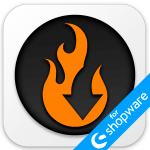
Regarding export file formats, Shopware’s options are somewhat limited since it primarily uses CSV files. But what if your partner specifically requests updates in XML format? The traditional approach involves converting CSV files into XML after exporting, which can be quite frustrating and time-consuming. Fortunately, there’s a more efficient method to update your partner’s system without the need for this conversion, and it’s facilitated by the Improved Import, Export & Mass Actions application for Shopware 6. This powerful tool offers comprehensive support for XML files in both import and export operations. In this article, we’ll guide you through the process of exporting XML files from Shopware 6. However, before we delve into the details, let’s take a moment to understand the distinctions between CSV and XML formats. Don’t miss our Shopware 6 XML import guide and be sure to explore our Shopware 6 Cookbook for additional valuable recommendations.

Table of contents
CSV vs. XML
A CSV (Comma-Separated Values) file is essentially a text document that uses commas as separators to distinguish different blocks of data.
On the other hand, an XML (Extensible Markup Language) file takes a more intricate approach to storing and transmitting data. It’s a file format that incorporates tags and text to meticulously structure and organize data. These tags adhere to strict syntax guidelines and envelop the text in the file that you intend to store.
The primary distinction between CSV and XML file formats lies in their fundamental nature. CSV is a straightforward text format where values are separated by commas, hence the acronym Comma Separated Values. In contrast, XML relies on tags to indicate relationships between entities and to store data related to complex objects.
CSV offers the advantage of being highly user-friendly and demands fewer technical skills to work with. Additionally, CSV files are notably smaller in size compared to their XML counterparts, requiring fewer computational resources.
Conversely, XML shines as a more adaptable and extensible format, making it ideal for the storage and exchange of intricate, structured data. Its flexibility makes it a preferred choice when dealing with complex information.
Here are the benefits of using XML files for Shopware 6 export instead of CSV:
- Structured Data: XML files allow you to structure and organize your data more precisely. With the use of tags, you can represent complex relationships between entities and store data about intricate objects in a well-defined manner.
- Flexibility: XML is a highly flexible format. It can accommodate a wide range of data types, making it suitable for handling diverse and complex information.
- Extensibility: XML files can easily adapt to changes in data structure or requirements. You can add new elements or attributes to your XML schema without disrupting existing data.
- Hierarchical Data: XML’s hierarchical structure allows you to represent data in a tree-like format, making it ideal for scenarios where data has parent-child relationships or multiple levels of nesting.
- Standardization: XML is a widely recognized and standardized format, making it easier to exchange data with external systems that also support XML. This can simplify data integration and interoperability.
- Metadata: XML files can include metadata that describes the data, its structure, and its meaning. This metadata can be valuable for understanding and processing the data.
- Complex Objects: XML is well-suited for representing complex objects with various attributes and properties. This is particularly beneficial when dealing with detailed product catalogs or intricate customer records.
- Data Validation: XML schemas can be used to validate the correctness and integrity of data. This helps ensure that the exported data adheres to predefined rules and guidelines.
- Industry Compliance: In some industries, XML is a preferred or mandated format for data exchange. Using XML can help you comply with industry-specific standards and regulations.
- Long-Term Compatibility: XML files are designed for long-term data storage and archival. They can retain their structure and meaning over time, making them suitable for historical data preservation.
All around, XML offers greater versatility and precision in representing and exporting data, making it an excellent choice when dealing with complex or structured information.
How to export XML files using the default Shopware 6 tools
Let’s explore how to export XML files using Shopware 6’s default tools. You’ll need to follow a two-step process. Shopware 6’s native export functionality primarily generates CSV files. Here’s how to navigate around this limitation:
Step 1: Export Data as CSV. You will first need to run a standard export procedure associated with Shopware 6:
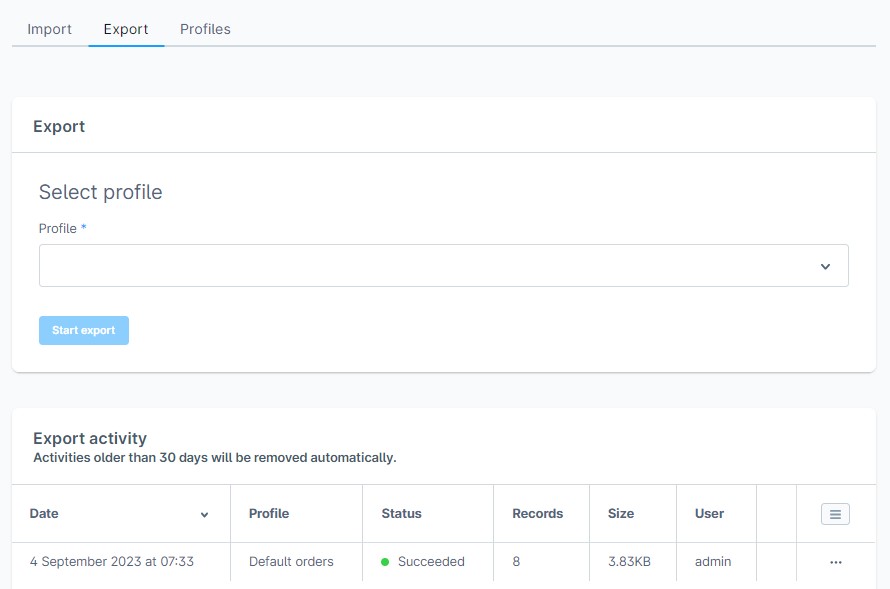
- Log in to your Shopware 6 admin panel.
- Go to the “Settings” menu and select “Export.”
- On the “Export” tab, choose the entity you want to export (e.g., Products, Customers, Orders) by selecting the corresponding export profile.
- You can configure the export options by editing the selected export profile.
- Click the “Start export” button. Shopware 6 will generate and prepare a CSV file containing your selected data.
Step 2: Convert CSV to XML. Since Shopware 6 doesn’t natively support XML as an export format, you’ll need to convert the CSV file to XML using a third-party solution. Here’s a general outline:
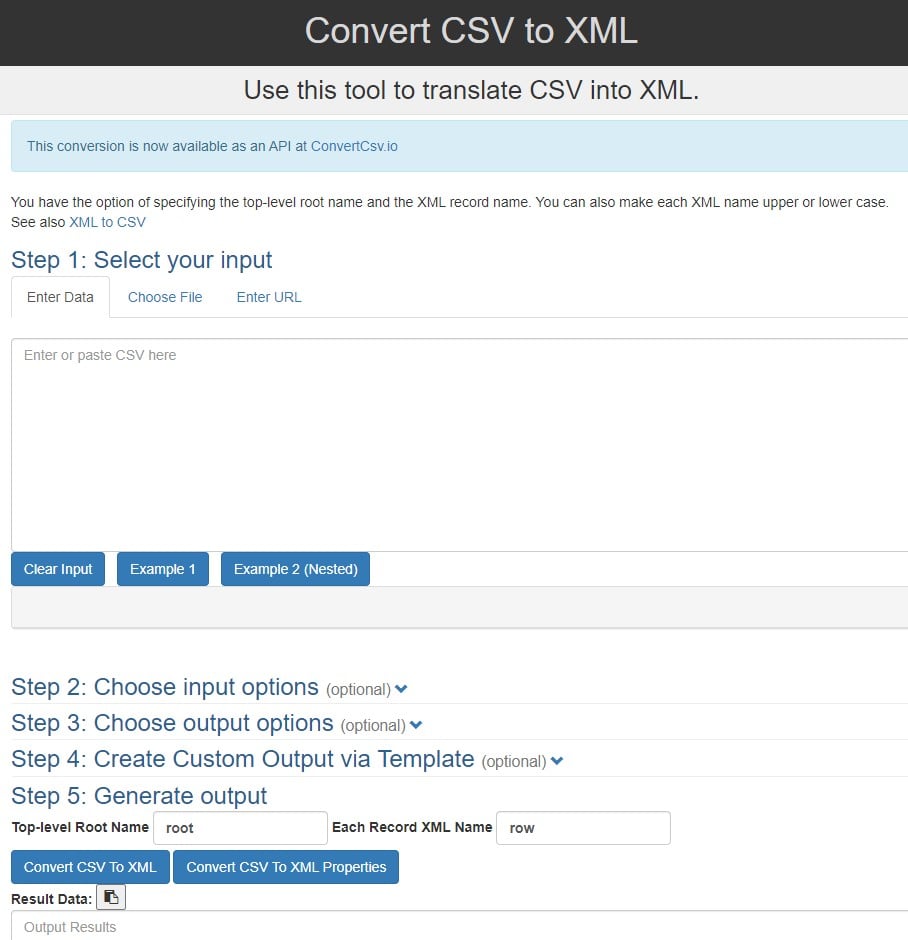
- Obtain a CSV to XML converter tool. Numerous online converters are available.
- Utilize the converter to transform the CSV data into XML format. We recommend using converters that let you map CSV columns to XML elements and attributes.
- Save the resulting XML file either locally or in a designated server location.
- Your data is now in XML format and ready for further use or sharing.
Please keep in mind that the exact steps and tools used may vary based on your unique needs and the complexity of your data. The key is to find a CSV-to-XML converter that aligns with your requirements. However, you can conveniently bypass this time-consuming conversion routine by utilizing the Improved Import, Export & Mass Actions application.
How to export XML from Shopware 6 without conversion
To configure Shopware 6 XML export with the assistance of the Improved Import, Export & Mass Actions application, simply follow these straightforward steps:
I. Create a New Export Profile
Begin by clicking the “New Profile” button, conveniently located under “Extensions -> Improved Import, Export & Mass Actions -> Product Export.”
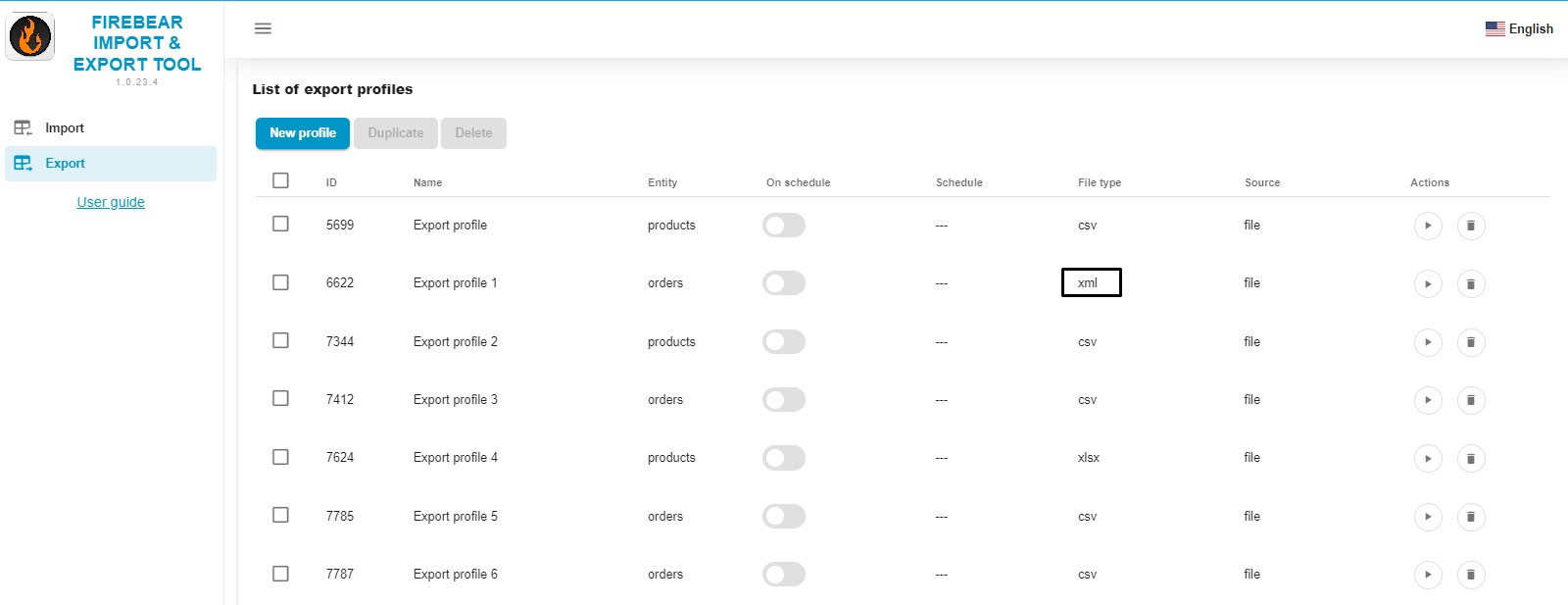
II. Configure Export Settings
On the “Configure export” screen, proceed with the following essential tasks:
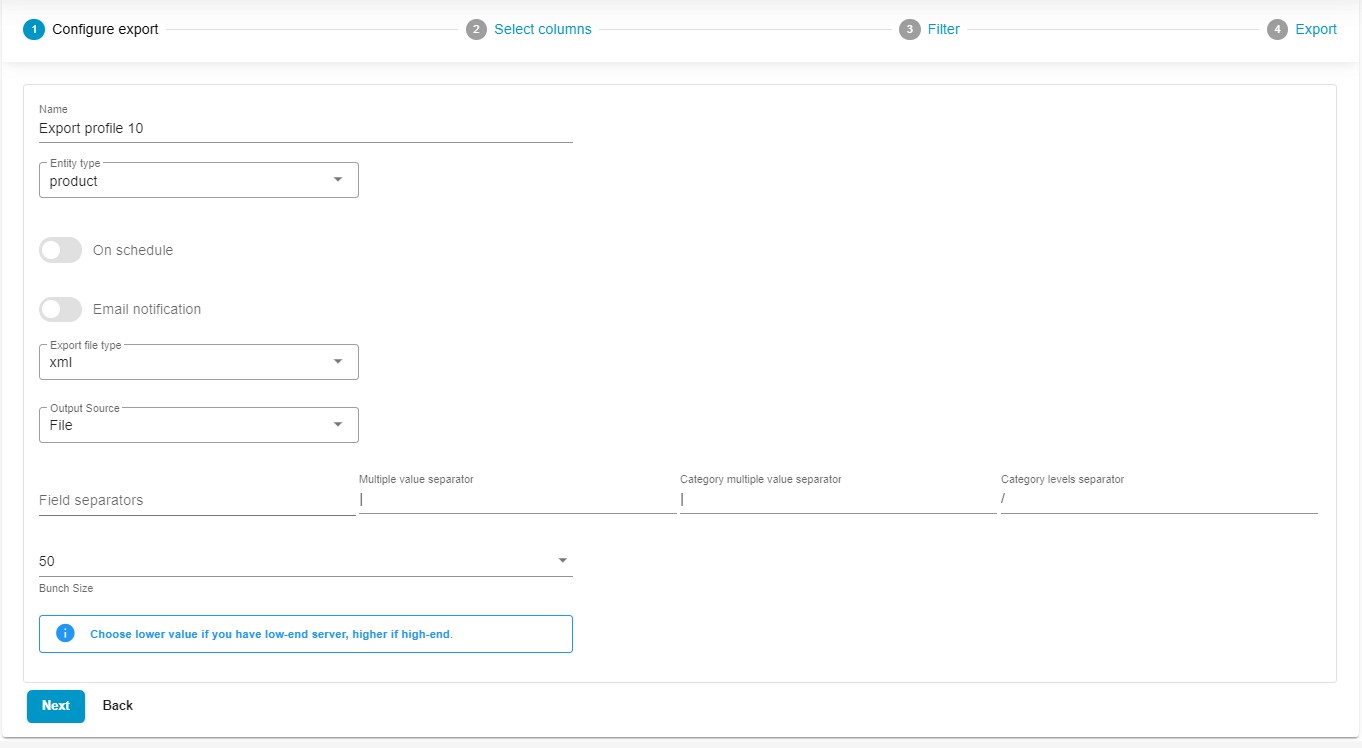
- Assign a title to your export profile.
- Select the entity you intend to export, whether it’s products, orders, or customers.
- If needed, establish a schedule for automated XML exports from Shopware 6.
- Set up email notifications for alerts on successful, failed, or both types of processes.
- Choose XML as your preferred file format. Additionally, you have the option to export XLSX and CSV files or Google Sheets spreadsheets.
- Decide on your export source, whether it’s FTP, Google Drive, or Google Sheets.
- For improved performance on low-end servers, specify a bunch size, opting for a lower value.
III. Customize Columns
Click “Continue” to progress to the “Select columns” screen, where you can tailor the column titles to match your partner’s requirements. It’s a place where you harness data mapping in Shopware 6. Simply add a new value (“Rename”) before the default column title (“Column”) that you wish to modify. Also, uncheck any columns that you prefer not to include in the export.
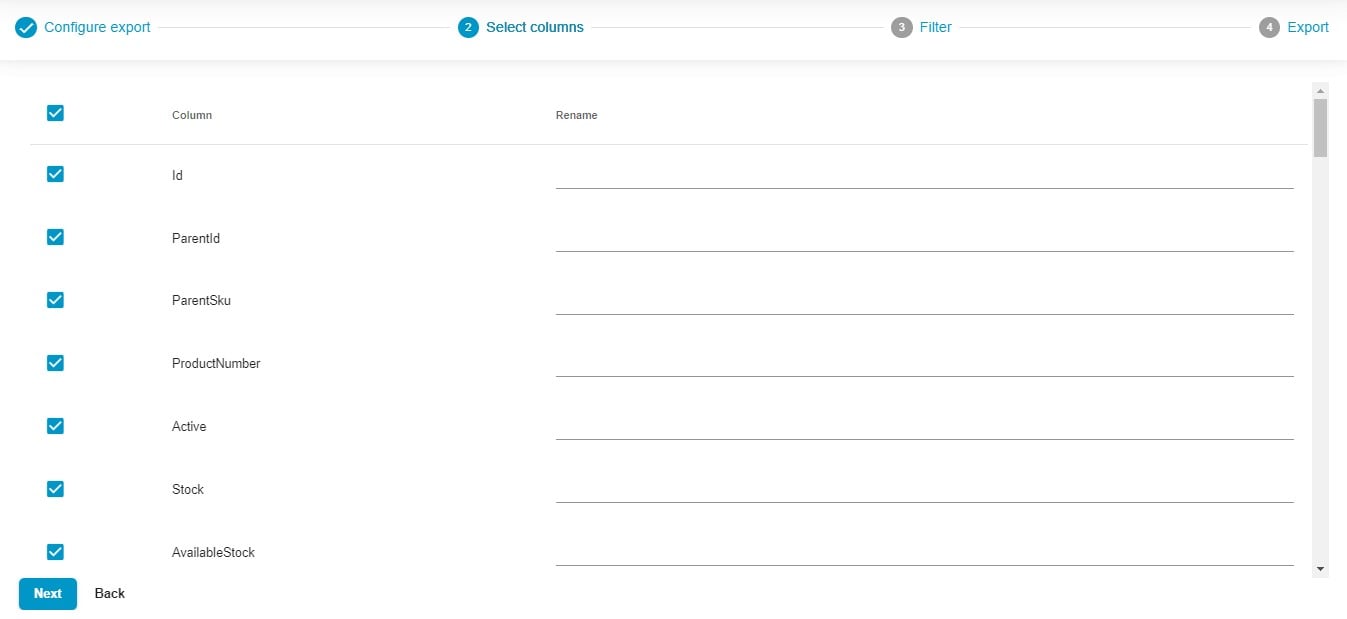
IV. Apply Filters
The third screen enables you to create filters to refine the selection of records in your output. For instance, you can export all products that are out of stock:

V. Save and Export
Click the “Save & Close” button to store your Shopware 6 XML export profile for future use. Alternatively, hit the “Export” button located at the bottom of the screen to initiate the export process immediately.

Following these steps will allow you to effortlessly set up Shopware 6 XML export. For more comprehensive information, please refer to our Improved Import, Export & Mass Actions Manual.
Other Features
As a Shopware 6 store owner, you have a powerful ally in the form of the Firebear Improved Import, Export & Mass Actions application. This universal instrument not only automates the import and export processes but also introduces a host of features that are missing in the default Shopware 6 setup. The tool revolutionizes data management in several impactful ways, including:
- Full Product Import and Export: Effortlessly manage product data and custom properties, ensuring your catalog is always up-to-date.
- Customer Data Handling: Seamlessly import and export customer details, streamlining customer relationship management for a hassle-free experience.
- Order Export: Efficiently export order data, providing valuable insights into transactions and sales analytics.
- Precise Data Mapping: Create meticulous data relationships to ensure seamless integration between your Shopware 6 store and external systems.
- Flexible Scheduling: Customize import and export schedules to suit your preferences, automating data updates.
- File Format Compatibility: Seamlessly work with various file formats, including CSV, XML, and XLSX, facilitating smooth data transitions.
- Google Sheets Integration: Effortlessly transfer data between Shopware 6 and Google Sheets for collaborative data management.
- Direct File Uploads: Simplify data import and export with direct file uploads, streamlining the entire data management process.
- Secure FTP/FTPS Uploads: Enhance data security during transfers with comprehensive support for FTP/SFTP protocols.
- Google Drive Integration: Optimize data file uploads with integrated Google Drive compatibility, enhancing accessibility and convenience.
The Firebear Import & Export Tool empowers Shopware 6 store owners to efficiently manage their e-commerce operations. From product catalog maintenance to customer data management and order processing, this application simplifies complex tasks, ultimately boosting the overall effectiveness of your online store. For more detailed information about this remarkable product, please visit:
- Firebear Improved Import, Export & Mass Actions for Shopware 6
- Firebear Improved Import, Export & Mass Actions Manual
- Contact us

